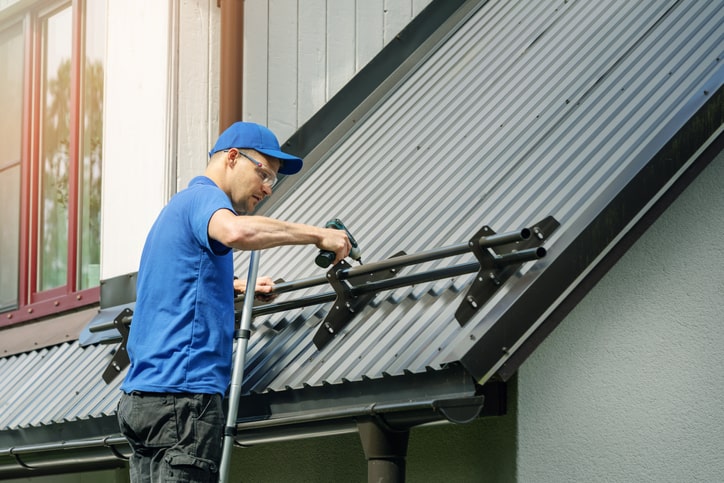Is Snow Guard necessary for a Solar Panel Installation?

Solar panels are often at the mercy of mother nature, and not just in terms of sunlight. If you're living up north, how much snowfall there is can have a huge impact on your solar experience.
Because sliding heavy sheets of snow off your roof can be dangerous. They can jam doors, get caught in window wells, dent cars, break windshields, and snap downspouts, but the most serious danger is to people and animals.
Your roof is usually textured to allow snowfall and release it without incident. However, the surface of your solar panels doesn't have the same qualities.
The top layer is usually made of glass or plastic, which makes them durable enough while still allowing a large amount of light to beam onto the film that collects electricity. This makes cleaning easy should small cracks happen in these layers, meaning they can easily be fixed with little effort.
However, glass tends to accumulate a large pile of snow on its surface. Once it reaches a certain amount it creates a mini avalanche and falls off all at once.
A typical solar panel can bear up to 800 pounds evenly distributed. A 12″ thick layer of snow weighs 9.39lbs per square foot. What that means a 144 sq ft array can easily collect 1,300 pounds of weight. We don't want this much weight to slide off in one large sheet.
In order to deal with this issue, snow guards are developed in an effort to prevent snow from piling up, and potentially free falling.
What is a solar power system snow guard?
Snow guards for solar panels are a safety measure that is becoming a popular way to reduce the risk of serious injury from falling snow.
Snow guards can be installed on your rooftop, like along an edge or ridgeline where you have solar panels, and will act as a barrier for any potentially dangerous free-falling snow.
The whole idea is minimizing the chances of snow falling at once, controlling the way how snow should fall off from the roof. They're usually made out of aluminum and can be in different heights depending on what suits your needs best.
Does your installation need a snow guard?
The majority of rooftop solar installations won't need solar snow guards. Installing a snow guard for solar panels depends on the amount of snow your region receives. If you're in a climate with heavy snowfall, your rooftop solar installation may benefit.
Also, if your roof structure is steep or tilted in such a way that the angle of incidence for falling snow could pose a risk to someone below, then you should consider installing solar power system guards.
Solar Panel Snow Guard Options
There are a wide variety of snow guard options on the market. It always makes sense to talk to your solar panel provider before making a decision. Since they may have complimentary snow guard choices that exactly fit your system or roof type.
Snow guards are classified into two types: clamp-on guards and snow fences.
Clamp-on Snow Guards
Clamp-on snow guards can be mounted along the perimeter of your solar panels or in between them.
These snow guards either slowly release small amounts of collected snow or allow the snow to melt naturally on the solar panels. Bear in mind that if you want snow guards to keep snow from melting then your solar energy production will decrease during the winter.
Snow Fence Snow Guards
The snow fence solution is built to mount to the roof separately from the solar panel in order to minimize the effect on the panel itself. These can be quickly installed after solar panels have been installed and on roofs that have yet to be equipped with solar panels.
How much do snow guards cost?
The installation cost of snow guards primarily depends on the type of model, manufacturer, roof size, and the number of solar panels installed on the rooftop. The average snow guard costs $2 to $5 per foot, plus labor for the installation if you hire someone for you to do it.
Installing snow guards with your solar panels will raise the upfront cost of adding them to your home. However, it will save you money in the long run by eliminating the need to have an installer up on the roof a second time and avoiding any harm caused by snow slides.
Therefore, before signing any paperwork talk to your solar panel installer if they can install snow guards for your home.
Panels with deicing capabilities
There are some solar manufacturers developed solar panels with deicing capabilities. This can be particularly useful for off-grid and commercial projects rather than residential grid-tied systems.
The system includes a snow density measurement system that is linked to a maneuver system, which is linked to DC power supply units via a switch setup.
These units are linked to the solar modules and can push power into the PV system if the panels are completely covered in snow and cannot function normally. There are systems that can melt about 2 kg of snow per square meter per hour which is pretty impressive.
Conclusion
The majority of roof installations will not need a snow guard. If you are in an area with heavy amounts of snowfall, then installing one may be worth looking into. It also depends on how steep/slanted the roofing structure is.
If there's any chance falling snow could pose some risk to someone below it might make sense to install one too.
If you do not have any experience with rooftop installations, then we recommend hiring someone who does know what they're doing. This will ensure optimal safety at all times.